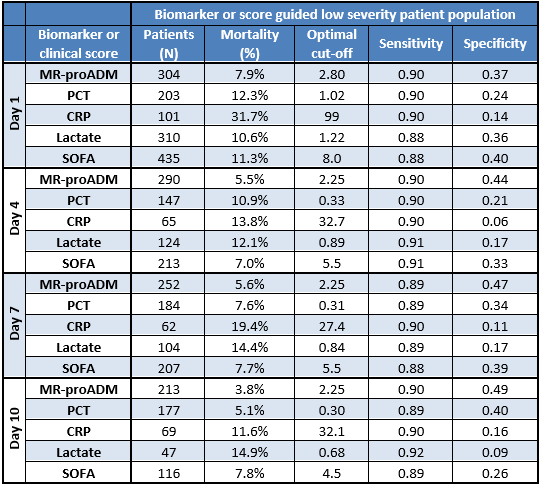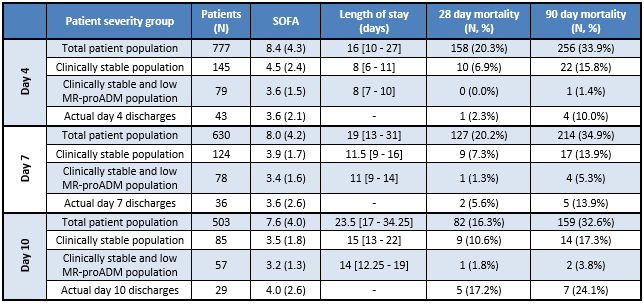Clinical Need: Early and Safe Intensive Care Discharge
An accurate assessment of disease severity can play a crucial role in facilitating an early discharge of low severity patients to a step-down unit. A study indicated that the use of MR-proADM between days 4 and 10 after sepsis diagnosis could consistently identify greater numbers of low severity patients with a lower 28 day mortality rate than all other biomarkers and clinical scores.
 Table 1. Biomarker or clinical score guided identification of low disease severity patients over the first 10 days of ICU treatment
Table 1. Biomarker or clinical score guided identification of low disease severity patients over the first 10 days of ICU treatment
Accordingly, 290 low MR-proADM severity patients could be identified on day 4, of which 27.2% were deemed as clinically stable with no further increases in MR-proADM concentration from the previous measurement. The average intensive care unit (ICU) length of stay (LOS) in these patients was 8 [7 - 10] days, with a 28 and 90 day mortality rate of 0.0% and 1.4%, respectively.
In comparison, only 43 patients were actually discharged from the intensive care unit on day 4, with a 28 and 90 day mortality rate of 2.3% and 10.0%. MR-proADM concentration analysis within the patient group found that 52.6%, 42.1% and 5.3% of patients were actually discharged from the ICU with low, intermediate and high severity concentrations, respectively, thus indicating an incomplete or insufficient treatment before discharge.
The use of MR-proADM measurements to identify low severity patients can therefore potentially facilitate a decreased intensive care unit (ICU) length of stay, and potentially drive down mortality rates and ICU readmissions.
 Table 2. Use of MR-proADM to identify patients potentially eligible for an early ICU discharge, in combination with an absence of ICU associated procedures or complications
Table 2. Use of MR-proADM to identify patients potentially eligible for an early ICU discharge, in combination with an absence of ICU associated procedures or complications
